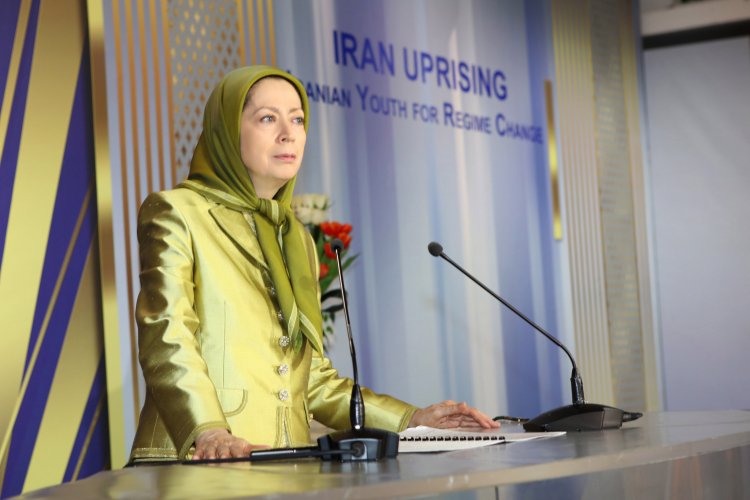Who Are the Organizers of the Iran Freedom Mass Rally?

Hundreds of Iranians are waving the flag of Iran before the Islamic Revolution, a flag that has a gilded Lion and Sun instead of the current Islamic calligraphy in the center. To the left, there's a grotesque caricature of the current Iranian President Hassan Rouhani portrayed as a venomous spider, ready to presumably pounce on Europe. To the right, people hold banners of protesters and opposition operatives supposedly killed by the Iranian government in the past few decades. In front lies a giant LED screen, and a woman, dressed as ornately as the backdrop behind her, suddenly fills the picture and begins talking about revolution, martyrdom, and the importance of democracy.
On February 10, 2019, at the Place Denfert-Rocherau in Paris, the National Council of Resistance of Iran, a front group for the insurgent group Mujahidin e-Khalq (MEK), presented itself supposedly as a force for democracy within Iran. However, the pure aesthetics of their rallies and demonstrations come eerily close to those of authoritarian regimes, and their history and conduct are not far from it either.
The Mujahidin e-Khalq, or the People's Mujahidin Organization, is a formerly Islamic Marxist insurgent group, now merely a nominally left-wing movement in favor of the overthrow of the current government of Iran.
A statue of Iranian President Hassan Rouhani as a venomous spider at the Iran Freedom Rally. Image Credit: Séamus Malekafzali
One man at the rally, when asked if a war to force a regime change in Iran could ever be a good option, was disgusted at the very idea, "War is never a good option," he remarked. He took the example of John McCain, saying that even though he flew a bomber in Vietnam, the Viet Cong did not kill him, and a result of their kindness, he came back and helped restore relations with the country after the war. While some of the MEK's supporters may oppose a war for regime change, the actual history of the group has portrayed the opposite of that stance. During the Iran-Iraq War, the MEK, after being forced out of Iran, allied with Saddam Hussein and participated in the last few offensives of the war. Operation Mersad, the main operation they participated in, was planned as a multi-pronged attack to drive into the center of the country and topple the government, but failed after only a few days, and led to the execution of untold thousands of MEK prisoners within Iran.
Iranians gather in front of the stage screen just before the start of the rally. Image Credit: Séamus Malekafzali.
When asked about what freedoms they would like to see emphasized in the post-Islamic Republic of Iran, many interviewees said “women’s rights” above all else. Despite undoubtedly putting women front and center in their media campaigns, including with their leader Maryam Rajavi, the MEK’s history with personal freedoms is much more complicated. Many MEK defectors tell of how men and women alike were forced to divorce their spouses for the sake of the revolution and were even asked to mentally divorce themselves from the very idea of marriage, despite the marriage of Massoud and Maryam Rajavi, the original leaders, being allowed to stand.
MEK supporters unfurl banner showing photos of hundreds of MEK prisoners who were executed during the 1988 purge. Image Credit: Séamus Malekafzali.
Matt Duss, a U.S. Senate foreign policy advisor, has gone on record as calling the MEK as popular in Iran as “salmonella”, owing to their work with Saddam Hussein and assassination operations in the early 1980s. One man, when asked if Iran truly wants the MEK, responded succinctly, “If they want us, we’ll stay. If they don’t, we’ll leave.” Despite their wide unpopularity, the MEK has long been courting U.S. political figures both popular and insularly powerful. Rudy Giuliani, former Mayor of New York City and lawyer for U.S. President Trump, and John Bolton, Trump’s National Security Adviser, have spoken at multiple MEK conferences, the latter claiming that he wanted to see the MEK in Tehran before 2019. Other politicians, like Senator John McCain, former Speaker of the House Newt Gingrich, international Prime Ministers, CIA officials, etc., have all spoken publicly at these events and called for regime change in Iran. According to The Guardian, financial disclosure documents show the MEK pays on average anywhere from $30,000-$50,000 per speech. John Bolton, in particular, was paid $180,000 one year for the multiple speeches he made at MEK conferences.
John McCain at a speech in favor of the MEK in April 2017. Image Credit: Flickr/Maryam Rajavi.
The MEK has held and will continue to hold protests, conferences, and rallies in countries around the Western world. However, is an organization, which exercises unprecedented control over its fighters, pays off politicians who orchestrated the wars in Iraq and Afghanistan, and has no real popularity in Iran, a truly viable alternative for the country?











